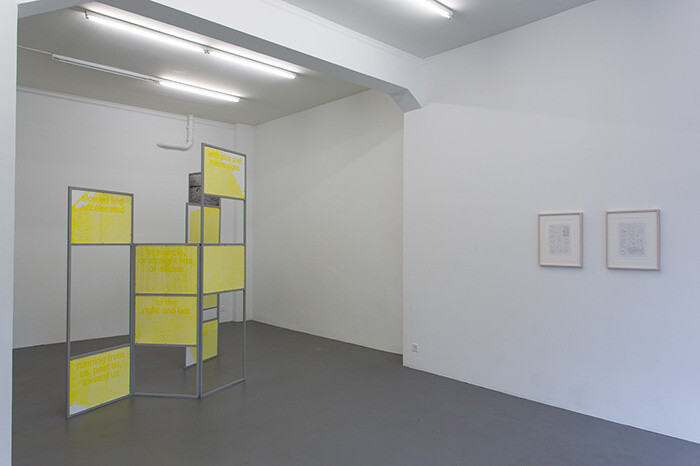A day prior to the opening of Alexandra Navratil’s “Plunge / Soar,” an article appeared in The Economist online suggesting that the low cost of human labor—brought even lower as other automated processes render people redundant—would be the major barrier to the widespread adoption of driverless cars.1 This interesting—and horrifying—thought has something in common with Alexandra Navratil’s concerns. For the Zürich exhibition, Navratil employs archival film and photographic material, as she has done for previous bodies of work that have focused on the technologies of celluloid, plastics, and applied color in film. Yet the show opens with two prints made from pages of The Economist, titled August 2014 and September 2014 (all works 2014): scanned reports of financial and economic news are superimposed and, from these, the artist has isolated the verbs that translate market movements into physical movements. Even in a publication that prides itself on objectivity, this prose tends to the purple. Prices may “rise and fall,” but they also “tumble,” “thrive,” “yo-yo,” “shoot up,” “surge,” and “rebound.” The words float over the otherwise masked pages, as if they concern only the immaterial processes occurring in a vacuum of their own self-righteous hyperbole.
The next work encountered in the relatively spare show, Buoyancy, consists of two folding screens. On one side, silkscreened black-and-white images of the Dutch East Indies (now Indonesia) in the 1920s depict workers drying the fiber kapok beneath a stretched cloth canopy, a labor-intensive process for a commodity then prized for its lightness. Within the field around them, the workers’ actions make a process of extracting value visible, one that could be presented on a graph of similar dimensions, tracking energy input and materials produced. Silkscreened on the opposite side of the display are phrases from Dziga Vertov’s text WE: Variant of a Manifesto (1922), which proposed a pure cinema unsullied by the dramatic artifices of other art forms, though once again Navratil has extracted only those terms that describe dynamics (which are “slowed” and “accelerated,” “to the right and left.”)2 By reducing the Manifesto to these bare elements, she tempers Vertov’s passion.
Vertov is best known for his 1929 film The Man with the Movie Camera, a cavalcade of impressions of Soviet life. While he often revealed the act of filming itself, observational “phantom ride” films—a popular early cinema genre, for which a camera was frequently affixed to the front of a train, gliding through a panoramic landscape, dissolving its own presence—provide the source material for the work Phantom 2 (entering/slide away), three prints two meters tall and nearly a meter wide each. The work reproduces three short films by filmmakers unknown from the Dutch historic film archive in Amsterdam, EYE. Here they are presented as filmstrips laid over a light box; on top, magnifying glasses highlight the few figures that appear in these landscapes through which the newly built railways cut, again in the Dutch East Indies of the 1920s. These workers and observers are indistinct characters, sometimes waving or raising hats to the camera, as if, their authors seem to suggest, welcoming progress.
In addition to her reflection on early sources of film materials and processes, Navratil’s use of archival footage illuminates certain dynamics of colonial wealth creation, illustrating, too, how film was instrumentalized to further imperial aims. (These films, for instance, were shown in Europe to entice settlers to the Indies.) In our post- or neo-colonial age, the images generate a frisson of inherited guilt, but with no particular implication, as their subjects are so distant; history alone has made them exotic to our eyes. So the investigation is informative, the connections drawn between technologies and politics insightful and they could provide useful parallels to consider in the current day, but might equally leave the viewer untroubled. It takes works like the Economist prints and the last remaining work in the exhibition, Phantom 1, to drive home the contemporary legacy of these historic images.
Phantom 1 echoes the tics of the historic films in a fashion that is so familiar to the viewer that they can no longer maintain a disinterested perspective. The work consists of a looping HD video less than one minute long, featuring a stock scene of unspoiled nature played across multiple screens in unison, the kind that might be used to advertise the quality of the monitors themselves. The image—a dramatic waterfall dropping into the sea—is filmed by a Phantom camera mounted on a drone which circles and swoops over the water. The footage seems to dictate that the lens or eye viewing the image is disembodied, free to soar and navigate at will, yet it also periodically points towards the sun to create a moment of camera flare and establish its “presence.” This magic marketing formula must be the right balance of untethered virtuality and groundedness. As journalistic reporting must find an acceptable equilibrium between transparency and showing too much, so too does this footage, no matter how obvious its mechanisms are. By extending the scope of her investigations to contemporary methods of image making, Navratil’s re-contextualisation of historic material gains a significant contemporary impact.
The Economist article about disembodied labor closed with the awkward question of whether “we should want millions of people […] doing jobs that sensors and computers could, and would do,” if only there wasn’t an excess supply of willing humans. Today, virtuality and high production values—such as those recreated in Phantom 1—obscure the effects of new technologies and their consequences, but is an attitude of indifference really sustainable? Just as the Dutch moved into Indonesia and developed trade while creating an underclass of the indigenous population, our bright new futures are likely to come at someone else’s expense. No wonder tumbling, twirling virtual images are so seductive.
Variant_of_a_Manifesto.pdf (accessed October 31, 2014)
Ryan Avent, “The human-driven driverless car,” The Economist (October 23, 2014). Available at: http://www.economist.com/blogs/freeexchange/2014/10/technology-and-productivity (accessed October 31, 2014).
“We: Variant of a Manifesto,” Vertov, Dziga, first published 1922, available in English at: http://monoskop.org/images/6/66/Vertov_Dziga_1922_1984_We_









